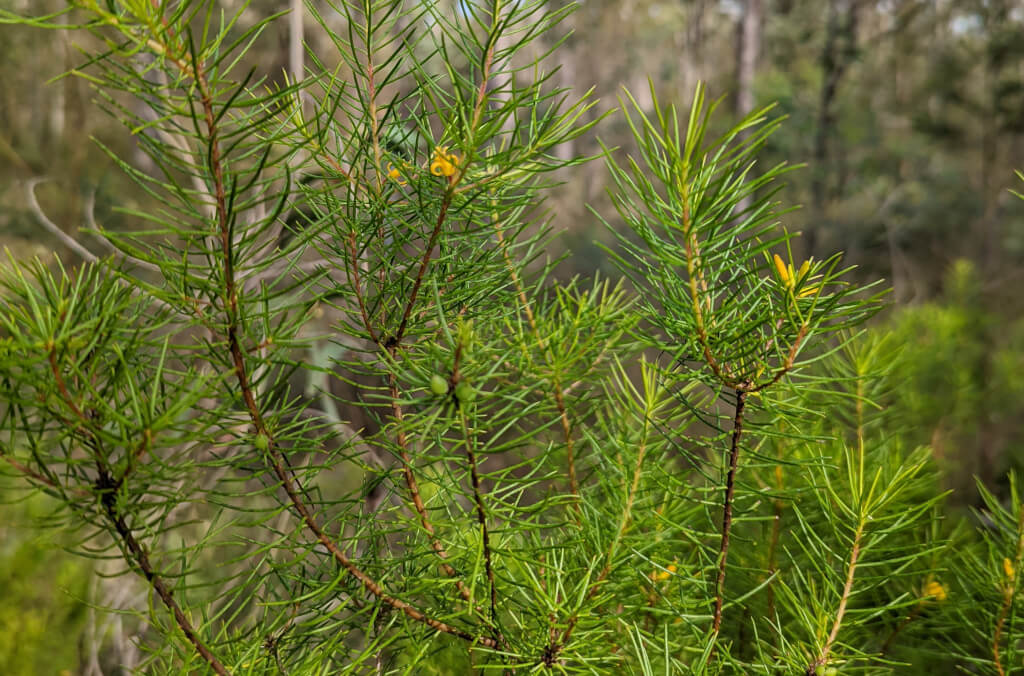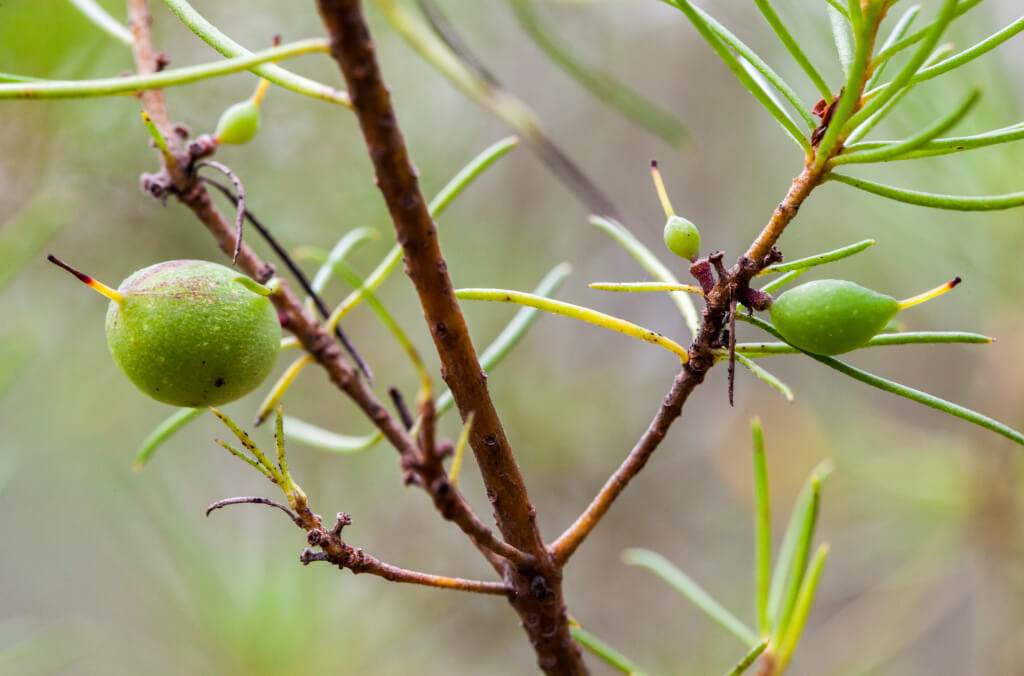Persoonia conservation and the power of community
In the lower Hunter Valley, a new nature reserve has become a sanctuary for one of Australia’s rarest plants, with scientists, First Nations leaders and the local community collaborating.
The New South Wales Hunter Valley is known for wineries, gourmet cheese, horse studs and coal mines. Less known however, is the regions’ unique plant diversity. The range of soils, geology and topography has created rich botanical diversity, with many vegetation communities and plant species endemic, or found nowhere else. However, with competing land use interests, some species are now threatened with extinction.
The newly created NSW National Parks and Wildlife Service 609-hectare Tiraki Nature Reserve recently became home to two new genetically optimised populations of the critically endangered and locally endemic plant, the North Rothbury Persoonia (Persoonia pauciflora). These new populations represent the culmination of many years of research and also typify the importance of collaboration and community support to conserve locally unique biodiversity.

A critically endangered North Rothbury Persoonia plant. Credit Nathan Emery.
As the name implies, this species is only found in the North Rothbury area. It has been the recipient of decades of dedicated conservation efforts incorporating passionate local landholders and Bushcare members, First Nations leaders, multiple government agencies including NSW National Parks and Wildlife Service and Saving our Species, private consultants and researchers from the Botanic Gardens of Sydney.
A carefully chosen Persoonia pauciflora, part of a new population designed using genetic data. Credit Chantelle Doyle.
Planting for the future
In autumn this year a contingent of people, drawn from all these groups, descended on Tiraki Nature Reserve bearing shovels and chatter, to create two new populations of the North Rothbury Persoonia. I was fortunate to be among them. The planting event was led by Katie Elsley from the NSW Saving our Species program and Riley McGee from NSW National Parks and Wildlife Service.
As we entered Tiraki and the site chosen for one new population, I was astounded by the crowd joining the effort. Over 30 people stood in the cool stillness of the ironbarks and spotted gums, ready to receive their planting instructions. This reserve is special, not just because it is one of the few remaining examples of the woodland which once characterised the landscape, but also because standing in this place feels like taking a deep inhalation. It is still and calming.
Although this was the fifth planting to occur, something new was underway. Each plant had a unique identification number and was clustered in a specifically selected group. Dr Samantha Yap, one of the planters, is also the geneticist from the Research Centre for Ecosystem Resilience (ReCER) at the Botanic Gardens of Sydney, who used genetic data to design these new plantings.
“Persoonia pauciflora occurs in such a highly fragmented and small geographic area that, when we create a new conservation population, we want to make sure we are representing as much of the wild genetic diversity as possible,” Dr Yap says. “Using genetics, we designed the planting clusters so that each individual is a unique genotype, or unrelated to another. That way we capture all the wild diversity and simultaneously encourage visiting bees to cross-pollinate plants, which we hope will produce genetically diverse seedlings.”
North Rothbury Persoonia flower. Credit Chantelle Doyle.
Dr Yap also emphasises that the goal of any translocation is to create a population that will recruit into the future, and that by encouraging a genetically diverse next generation, the species is more likely to survive threats like disease or climate change. Applying genetics is the culmination of many decades of work, and one of the people in attendance has been involved since the very beginning.
Discovering the species
Gordon Patrick is a consultant botanist with the unique claim of discovering this species as new to western science. “This plant has a place in my heart,” he says. “Back in 1998 I came across a plant and wasn’t sure what it was, so I sent it to the Herbarium and three months later got notification that it was probably a new species. Considering this plant occurs in a place that has been so disturbed for 200 years, it is amazing that it is still here.”
Gordon has a lot of experience with translocations and knows that success is far from guaranteed. “It is very hard for translocated plants to survive, let alone reproduce. It is a testament to the planning, location choice and research undertaken that these translocations have such high survival, and even that some seedlings are starting to appear.”
The importance of planning and research
Translocations are not about moving plants. They are vital to combat extinction by establishing a foundation towards a more successful self-sustaining population and help to ensure species survival, for generations to experience. Successful translocations are rarely, if ever, reported as the development of self-sustaining populations takes time and even the initial plant survival and growth can be tricky. Dr Nathan Emery from the Seedbank at the Botanic Gardens of Sydney has researched Persoonia ecology and biology for over a decade.
Nathan’s work has confirmed the North Rothbury Persoonia are pollinated by Leioproctus bees and that plants produce more fruit if cross-pollinated between isolated populations, which is essential information to support the genetic advice. His field studies identified that the hard woody endocarp naturally weakens when buried and it can take up to two years of aging in the soil before seed dormancy is overcome and summer germination pulses begin.
Understanding a species ecology is critical to choosing a suitable translocation site with pollinators present. Additionally, understanding seed biology, including dormancy mechanisms and germination triggers, helps conservationists estimate how many years it may take for natural regeneration to occur from the translocated population.
Pilot plantings to understand aftercare and microhabitat or niche, are also required and have been critical to long term succuss. For a species whose wild populations occur almost exclusively on private land, finding translocation sites can be very difficult. This is why the project has relied so strongly on local residents and the North Rothbury Bushcare Group.
The power of community
Existing woodlands within the Hunter valley are highly fragmented and poorly protected, meaning that Persoonia pauciflora has relied heavily on private landholder conservation. Nathan introduces me to Monica Oppen, one of the local landholders whose private property was the site of the first pilot translocations after putting the property under a legally binding conservation agreement with the NSW Biodiversity Conservation Trust.
“As soon as I found out about the Persoonia I went looking for it and found it along a road verge near our land.” Monica says, “Finding the first seedling was pretty exciting. I tag and fence every seedling I come across on my block.”
Because the Persoonia occurs predominantly on private land, the NSW Saving our Species team are reliant on the community group in North Rothbury. “There aren’t a lot of us, but all you need is a few dedicated people,” Monica says. “We monitor the plants, check them and let Saving our Species know if we find new plants.”
Ensuring the plants survive
Many translocations require subsequent maintenance including watering, but unfortunately for the North Rothbury Persoonia, its soft foliage is very appealing to grazers like macropods and feral herbivores. This has meant that an added layer of very secure industrial fencing is required to protect the plants while they grow and, ultimately reproduce.
Funding from the NSW Saving our Species program and National Parks and Wildlife Service has ensured that the post planting care is best practice and, encouragingly, early pilot translocations between 2015 and 2019 are not only mature and fruiting, but the first generations of seedlings are appearing.
This result is thrilling because it means that firstly, the translocation methods applied are working, but also that these new populations are now the largest on publicly protected land.
The future for the North Rothbury Persoonia
Ensuring that healthy populations of plants continue to occur on dedicated conservation land is critical because, for foreseeable future at least, this species will rely on translocation and maintaining surrounding areas of its woodland habitat. The ecological value of its nectar-rich flowers and drupes is only beginning to be understood, however camera monitoring has identified bower birds foraging on seeds and, presumably, spreading them across the landscape.

North Rothbury Persoonia fruit, known as drupes. Credit Nathan Emery.
Increasing community awareness and support for this species will continue to play a vital role as conserving more plants on private land is crucial to this species survival. Upcoming seed dispersal trials utilising seed from both translocated and wild plants will help improve the teams’ understanding of seed viability and germination.
More great stories like this feature in The Gardens magazine, the member magazine for Foundation and Friends of the Botanic Gardens. Join the community that supports and raises funds for Botanic Gardens of Sydney.